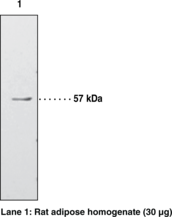服务热线
021-60498804
产品中心
/ Products Classification 点击展开+
| Cat. Number | 702096745195402 |
||||||||||||||||||||
| Chemical Name | PPARγ Polyclonal Antibody |
||||||||||||||||||||
| References |
Background ReadingGreene, M.E., Blumberg, B., McBride, O.W., et al. Isolation of the human peroxisome proliferator activated receptor γ cDNA: Expression in hematopoietic cells and chromosomal mapping. Gene Expr 4 281-299 (1995). Fajas, L., Auboeu, D., Raspé, E., et al. The organization, promoter analysis, and expression of the human PPARγ gene. J Biol Chem 272 18779-18789 (1997). Elbrecht, A., Chen, Y., Cullinan, C.A., et al. Molecular cloning, expression and characterization of human peroxisome proliferator activated receptors γ 1 and γ 2. Biochem Biophys Res Commun 224 431-437 (1996). Thuillier, P., Baillie, R., Sha, X., et al. Cytosolic and nuclear distribution of PPARγ2 in differentiating 3T3- Spiegelman, B.M., and Flier, J.S. Adipogenesis and obesity: Rounding out the big picture. Cell 87 377-389 (1995). Lemberger, T., Desvergne, B., and Wahli, W. Peroxisome proliferator- Mukherjee, R., Jow, L., Croston, G.E., et al. Identification, characterization, and tissue distribution of human peroxisome proliferator- Show all 7Hide all but first 3
DescriptionAntigen:human PPARγ1 amino acids 82- 1Greene, M.E., Blumberg, B., McBride, O.W., et al. Isolation of the human peroxisome proliferator activated receptor γ cDNA: Expression in hematopoietic cells and chromosomal mapping. Gene Expr 4 281-299 (1995). 2Elbrecht, A., Chen, Y., Cullinan, C.A., et al. Molecular cloning, expression and characterization of human peroxisome proliferator activated receptors γ 1 and γ 2. Biochem Biophys Res Commun 224 431-437 (1996). 3Spiegelman, B.M., and Flier, J.S. Adipogenesis and obesity: Rounding out the big picture. Cell 87 377-389 (1995). 4Lemberger, T., Desvergne, B., and Wahli, W. Peroxisome proliferator- 5Fajas, L., Auboeu, D., Raspé, E., et al. The organization, promoter analysis, and expression of the human PPARγ gene. J Biol Chem 272 18779-18789 (1997). 6Mukherjee, R., Jow, L., Croston, G.E., et al. Identification, characterization, and tissue distribution of human peroxisome proliferator- 7Thuillier, P., Baillie, R., Sha, X., et al. Cytosolic and nuclear distribution of PPARγ2 in differentiating 3T3- |
||||||||||||||||||||
下一个:PPARα Polyclonal Antibody上一个:没有了 |
|||||||||||||||||||||





